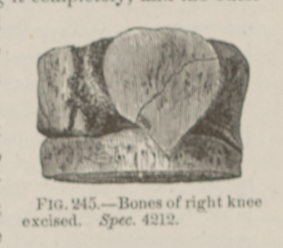Title: Sims, J.
Source text: The Medical and Surgical History of the War of the Rebellion. (1861-65.), Part 3, Volume 2 (Washington, DC: Government Printing Office, 1883), 394.
Civil War Washington ID: med.d2e16616
TEI/XML: med.d2e16616.xml
CASE 627.—Corporal J. Sims, Co. B, 4th Ohio,¹ aged 23 years, was wounded at Mine Run, November 27, 1863, by a conoidal ball, which entered the right knee joint just below the patella, on the inner and anterior aspect, fracturing the inner condyle and opening the joint, passed downward and forward, and was extracted about four inches from point of entrance. He was admitted to the Second Division Hospital, Alexandria, December 5th. "At the time of admission the joint and thigh were very much inflamed and discharging pus copiously, and the man was much prostrated and terribly anxious as to the result of the wound. But after being washed and fed and otherwise cared for, he appeared much recruited. On the 8th of December the operation of excision of the knee joint was performed by Surgeon E. Bentley, U. S. V., who removed one inch of the femur and about one and a half inches of the tibia and fibula. The hæmorrhage was slight, but the condition of the tissues was not very satisfactory. The patient endured the operation well under the influence of chloroform, and reacted well. On the following day he complained of severe pain over the lung on the right side of the chest, which continued for several days. On the 10th, he had a severe chill at night, which was followed by two, more severe, on the 11th. Stimulants were freely given with raw eggs well beaten up, and beef essence for diet. He continued to have chills till the night of the 13th, when he was seized with a very severe one, from which he never rallied. He died on the morning of December 14, 1863. The post-mortem examination showed no attempt at repair, there being considerable sloughing, while on the inside of the thigh there were numerous small abscesses. The heart and left lung were healthy, but the right lung was infiltrated with pus, and a single large abscess appeared upon the surface of the inferior lobe. There was no pus nor abscess found in the liver, but it was very much softened." The history, with the post-mortem specimen, represented in the cut (FIG. 246), was contributed to the Museum by the operator. Surgeon J. B. Brinton, U. S. V., who examined the limb two days after the patient's decease, found "the whole joint one suppurating mass; pus extending up and down, far down under the gastrocnemius and up between the muscles on the inside of the thigh; a long abscess in the sheath of the vessels, extending up to the middle of the thigh; small clot in femoral artery, thin and three inches long; none in femoral vein; surrounding tissues of vessels hardened in some places where pus had not readied; long membrane of femoral vein of dirty gray color and softened; clot in saphena vein."
¹ See Circular No. 6, War Department, S. G. O.. Washington, 1865, p. 59; CULBERTSON (H.), Excision of the Larger Joints of the Extremities. Prize Essay, in Trans. Am. Med. Assoc., Philadelphia, 1876. Supplement to Vol. XXVII, p. 184, Case 13.
